
Let's Talk Leadership
Learn - Inspire - Lead
I Am Because We Are...
You’re probably wondering what my title means, “I am because we are,” let me tell you what I mean by that. I believe an effective leader should have this mindset; they are who they are because of the people around them. I believe it is so important to be one who believes in others and not just themselves. I live by this quote now, and I will do so in the future as well when I have a bigger role. Leadership is finding the beauty in how you’re going to lead people, inspire them to become better, and learning from them. I have high expectations of the type of leader I aspire to be:
-
Motivate others- I believe a leader who motivates others automatically creates a peaceful atmosphere in the work place. If you are constantly motivating people to become better and work harder, their commitment to the organization will increase and they will not dread coming to work, the will actually enjoy working around a leader who motivates them.
-
Be patient- being patient is the key to any successful leaders. If someone makes a mistake, it is crucial to keep in mind to not lose faith in them and motivate them to keep trying. Always remember that leaders should be willing to always and be patient.
-
be humble- leaders who think they know everything and have a high ego, certainly don’t. Great leaders never stop learning no matter how long they’ve been in the industry and you can definitely learn something from others even if they have a much lower position than you.
-
Communicate- I have met and worked with leaders who do not communicate with their team and let me just say, it is a mess. Seeing leaders not communicating well with others motivates me to do the opposite of what they do, now and in the future.
-
Listen, listen, listen- it is sad how many times I haven’t been able to speak up for multiple reasons whether I know my manager won’t have time for me, or me being afraid, etc. Great leaders should welcome their employees to speak and say what is on their minds.
It’s important to follow all the steps above to be an effective leader, but it is also important to set limits and be fair. I have met leaders throughout the years who I aspire to be like, and ones who I will always remember to not become like. The (5) values listed above are the most important to me and I aspire to become someone who will be able to follow them.




Traits & Me...
I truly believe that great leaders have certain traits that make them the excellent leaders they are. Some of those traits I love are:
1. Honesty- honest people are the ones who would say: “I value integrity.” I admire honest people, especially those who don’t hide around the bush and get away with lying. I appreciate people who also are honest about their mistakes and admit their wrongs. Those who admit their wrongs are the ones who truly make a difference whether it is in my personal or professional life.
2. Ambitious- ambitious people are ones who would say: “I am driven by success and to succeed.” I admire people who never stop running, there is a quote that says, “leaders eat last” and those who do eat last are the ones who never stop looking for their next goal and mission. Having a trait of being ambitious makes people look up to you and love to be around you. Compare a lazy person that does nothing and sits around all day and someone who is ambitious and never stops saying “what do we have next?”, which person would you prefer to be around? The answer is clear.
3. Enthusiastic- enthusiastic people are the ones who would say: “no one will bring down my mood and optimism.” this is one of the most important traits in my opinion. Let’s be honest, no one appreciates or likes to be around a pessimistic, enthusiastic people put their all in their work whether they are solving a problem at work or working on a new project.
4. Curious- curious people are the one who would say: “I am eager to learn new tasks.” It is always nice to be around people who are not stuck to doing their everyday routine job, but like to step out of their comfort zone to want to learn something new.
5. Cooperative- those are the ones who would say: “I get well with others.” This is super crucial in every industry out there, especially the hospitality industry since we are focused on customer service. Being cooperative means that you are willing to work with others who don’t necessarily have the same personality as you.



Pros & Cons of Traits Theory...
Trait Theory and Great Man Theory differ in terms of what they truly mean. Trait Theory, as described in the article Trait-Based Perspectives of Leadership written by Stephen J. Zachary “leader traits can be defined as relatively coherent and integrated patterns of personal characteristics, that foster consistent leadership effectiveness across a variety of group and organizational situations”. In other words, Trait Theory demonstrate being a leader by having certain characteristics such as having cognitive abilities, personality values, intellectual skills, social skills, etc. What Stephen Zachary means, is that leaders shouldn’t be leaders because of their titles, their performance should speak volume first then they will be considered leaders. One of the Pros of Trait Theories is that leaders are distinctive, meaning they rare and unique. The Cons or flaws of Trait Theory is that leaders are “centric”, meaning they don’t usually focus on the situation or the people involved in the situation. This could be a huge issue in the real world, because being a leader in a situation and solving the issue on your feet explains a lot on how you are able to handle a situation. On the other hand, Great Man Theory measures leaders, meaning they cannot be made, they are born as leaders. This implies that leaders who do not possess the right traits, will never be able to become a successful leader. In my opinion, the Pros of Great Man Theory is that leaders born knowing so much information, who strive to keep learning and to never stop chasing education. A Con of this theory would be that if you are not born a leader, you do not have the protentional to become one. I agree and disagree to a certain extent on this. I do believe that there are many people out there who were made to be leaders, whether it’s with the way they work or the way their brain functions. However, not everyone is born with leadership skills; for example, if someone is not good at communicating, they can learn how to effectively communicate with others. I do believe that leaders CAN be leaders if they put their heart and souls into wanting to become one, but I do not believe that those who are not passionate about being a leader are able to become one. If every leader in the world was born to become one, we would not see half of them and where they are today.
Understanding Theory
The Leader Member Exchange is a theory that focuses on managers and their workers, or what we can say leaders and their followers. The LMX Theory has three phases of leadership:
Phase 1: stranger- or what we can call “role taking.” This is when a member joins the team and the leader demonstrates their abilities and skills. Followers in this phase do not trust leaders but are willing to follow, listen and learn in return of certain benefits.
Phase 2: acquaintance- or what we can call “role making.” Trust building is very important in this stage. Relationships start to develop and strengthen.
Phase 3: partnership- or what we can call “routinization.” In this phase, a pattern between the leader and member becomes established and fully develops.
The LMX theory relates to the show, Prison Break. This show is about a framed murder of Lincoln Burrows that gets stuck in prison for a crime he did not commit, in which his brother, Michael Scofield makes a mission to help him escape. Since phase 1 demonstrates how a member joins the group, this relate back to the show of how Michael went to prison purposely to help Lincoln. Michael committed crimes purposely in order to help his brother escape and lived in prison in return of certain benefits which in this case, would be finding a way to help his brother escape. Just like what phase 2 demonstrates, the start of relationship building, Michael meets Sara, who is the nurse that takes care of the inmates in the prison. At first, Michael did not trust her and thought she was like everybody else, careless and heartless. However, Sara and Michael started to develop a relationship together. The last phase measures partnership, which is when the relationship is completely established. Michael ends up telling Sara the entire story of his brother, Lincoln, and she starts to slowly help him and they end up falling in love. Sara helps Michael because she finds out that he is truly innocent. You might ask, how is this relevant since Michael is not a “leader” in the show? Michael definitely plays the role of being a leader in the show, he builds relationships with other inmates to help them and himself escape.
Learn
Leadership
Inspire
Motivate
Grow
Teach
Empower


Application to Self
Gary Yukl’s article on flexible leadership was very interesting to read. He signifies behavior theories and focuses on the importance of being a flexible leader. “The purpose of clarifying behavior is to guide and coordinate work activity and make sure people know what to do and how to do it.” This specific quote stood out to me because in the hospitality industry, this seems to lack all the time. Many times, people are afraid to speak up initiating they are confused on something because they are afraid they will be punished for not knowing how to do a certain task. Yukl’s way of pointing out that people need to know something in order to know how to do it is the correct way and every leader should have this mindset. In addition, he mentions specific behaviors that all leaders must have:
Developing: Developing is showing someone how to do something instead of telling them how to do it. It is important to do that for that person to learn from their mistakes and avoid making the same mistakes over and over again.
Recognizing: Yulk believes that people need to be recognized and rewarded for their accomplishments. I also believe that recognition motivates employees to do better and contribute more to the organizations success.
Consulting: Yulk points out that hundreds of studies have evaluated consequences of participative leadership.
Supporting: Supporting is showing acceptance and consideration, even in difficult situations. Being a supportive leader will help boost the energy of your employees and the people who are around you as well.
Empowering: Empowering doesn’t only mean to make decisions and ordering your employees to finish their duties, it is giving your employees the autonomy in situations which will result in your employees to stay more committed to the organization and satisfied with their jobs.

The book, “Good to Great” by Jim Collins measures (5) major levels of leadership that Collins explains that every leader must have:
Level 1: Highly Capable Individual- at this level Collins believes that leaders must have a variety of skills and talents to perform a certain job.
Level 2: Contributing Team Member- at this level, leaders should contribute to individual’s capabilities of achievements and work effectively in a group setting with others.
Level 3: Competent Manager- this level requires organizing people to achieve goals and objectives.
Level 4: Effective Leader- this level catalyzes commitment to pursue a clear vision and stimulating higher performance standards.
Level 5: Great Leader- at this final level, you have all the four-other level and abilities that will help you achieve greatness at a professional will.
Those five levels of leadership relate to my own leadership experience that I have worked on and continue to work on in my professional career. Although I am not at level 5 yet, I am working thoroughly to get there. By practicing the five levels of leadership, I believe that it will help me get one step closer to my long-term goal. Titles do not necessarily mean everything, if you don’t have a title like “supervisor” or “manager”, it does not mean you are not a leader. You can simply lead others in many different ways, I believe humble and effective leaders can easily reach level 5 if they are following the first 4 steps the correct way.

Blanchard's Situational Leadership Module
Blanchard’s Situational Leadership Model measures an individual’s leadership style based of off specific behaviors. After reading this article and learning in class where which style I fall under, I discovered that I am a mix between supporting and coaching. Like I mentioned in class, I believe supporting and coaching tie to one another tremendously. For example, even if I am not being coached on a specific task, I am going to appreciate some support and the other way around, supporting others while you are in the process of coaching them is crucial in the Hospitality industry. A negative mismatch may be for example, if someone takes something the wrong way. Often times I have worked with people who do not really think they need coaching or supporting, they think they know what they’re doing without need guidance. I believe that it is super important for an individual to look at this the other way, it may be a negative thing in their head but in fact, it is not a negative thing. In my previous role, I encountered my co-worker who was having trouble delivering all the food to one of our biggest events including 500 guests, she was fairly new to the team and was not sure which side of the hotel the event was going to take place. I stepped in and believed that she was able to get the job done with the support I gave her. Instead of myself doing the job for her, I supported and coached her by giving her a mini paper that has the list of where everything is located. I told her that this paper helped me tremendously memorize where every ballroom is located along with supporting her by believing that she was able to get the job done properly. I was a leader in that role in which I watched my co-worker struggle with a task but stepping in and coaching, supporting and helping her instead of fully taking charge.

Level 5 Leaders
The level hierarchy includes 5 levels: level 1 is a highly capable individual, level 2 is a contributing team member, level 3 is a component manager, level 4 is an effective leader and finally, level 5 is an executive leader. It is important to remember that each level of this hierarchy is effective based on the situation happening. According to Jim Collins, “Level 5 leaders channel their ego needs away from themselves and into the larger goal of building a great company. It’s not that level 5 leaders have no ego or self-interest, they are incredibly ambitious- but their ambition is first and foremost for the institution, not themselves.” This quote stood out to me because it is so true! In the real world, some people might think that they’re “too good” to accomplish a task because their position is higher than others. However, that is the wrong mentality to have. Being able to put your preferences and feelings aside and focusing on the organizations needs should always be your #1 priority as a leader. Defining Level 5 Leaders is “a blend of personal humility and intense professional will.” In my opinion, I believe those type of leaders are able to quickly adapt to new people, new companies, and new environments and are definitely using the situational leadership theory which measures leaders who are able to use their leadership skills based of off specific situations in the work force. For example, if a leader is known to have things done by the first hour their employee clocks in and the opposite ends up happening for any reason, for example, if the front desk was very busy, that leader is able to understand and adapt to the situation that is happening. Rather than getting frustrated at the employee, they are able to understand the situation and think of the bigger picture of the situation. All in all, the 5 level of leaders relies not only on the leader, but on the situation and follower as well.

Nominations
After reviewing my classmate’s blogs, I was able to determine my nominations for the following categories:
Courage – shows a lot of connection to self and shares personal information, Erika’s site has many personal examples and stories of her previous experiences which shows how courageous she is to share her stories with others.
https://erikaleadershiplife.wordpress.com/
Coherence – the site has a consistency in the theme and “voice”; Bianca’s site made me pay attention to her website by how consistent her stories are and the voice she was using throughout her blog.
https://biancachang422.wordpress.com/
Crafty – the site is visually appealing; Kassandra’s theme and website were filled with awesome and appealing photos!
https://kassandrasjourney491.wordpress.com/
Clever – the site kept my interest with cleverness or humor; Vanessa’s site caught my attention with the clever references and the photos she had throughout discussing different topics.

Good to Great by Jim Collins
“Good to Great” by Jim Collins really makes you think about the steps you must take in order to become GREAT instead of just being GOOD. Collins believes that being good isn’t enough, he believes everyone has the capability to think outside the box and think of something that is actually great. This book made me realize how creative people may be if they take the time to think of a certain situation. Additionally, the author mentions how important leadership is and the different ideas that build something that would be considered world-class such as the hedgehog concept. This concept stood out to me the most. The hedgehog concept reflects on someone who is super good at one specific task instead of being “okay” on multiple tasks. Collins refers to this concept in a way to make a point that companies should follow this concept and they will begin seeing happier employees. If someone is really good at performing a task, they will keep doing the great work they’re doing and will love doing and sticking to their job. All in all, this book is truly inspiring, relatable, easy and finally, fun to read!

Transactional vs. Transformational Leaders
A transactional leader generally does not look ahead in strategically guiding an organization to a position, instead, these types of leaders are usually concerned making sure everything flows smoothly in their organization. However, transformational leaders are the total opposite. Those managers or leaders go above and beyond managing day-to-day operations and taking ownership in situation that may arise in their company. For example, a transformational manager is one who does their best trying to better the business, and does not care too much about getting recognized for it. Those managers or leaders know that their strategic thinking is benefiting the business and inspiring their employees by setting higher performance while providing opportunities to think strategically as well. An example of a transformational leader I know is someone whom I work with. This person has been working at the front desk for 12 years, she knows the ins and outs of the business, performs and resolves managerial level conflicts, yet, does not care that she does not have the title of being a leader or a manager. Putting that aside and looking at the bigger picture, she knows that she is a transformational leader and she is always willing to go out of her way to help someone out. I believe those types of leaders are the ones who will go very far in life, not only in their professional careers, but their personal lives are well.

Steve Jobs & the (4) I's...
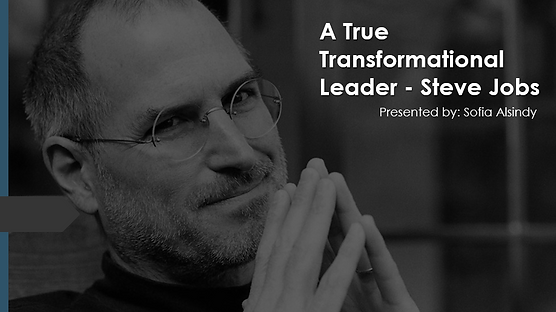




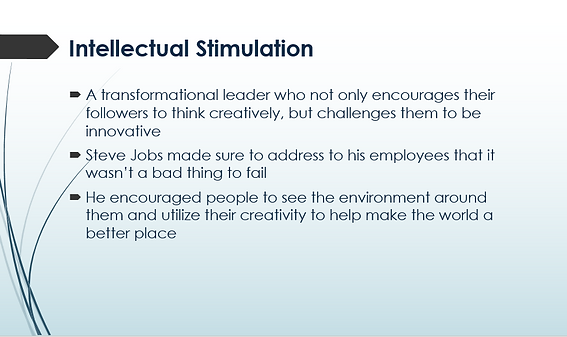
Power & Influence Theory

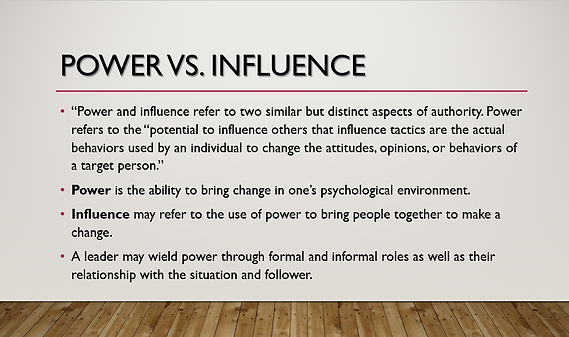

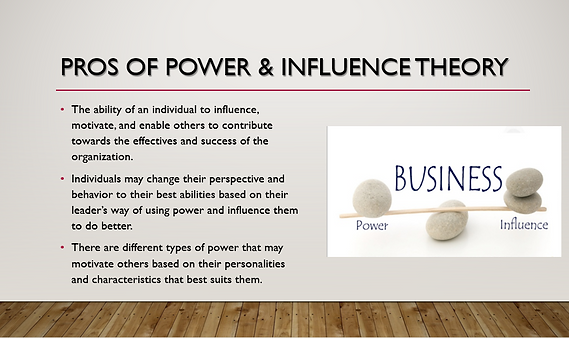

The Leader in Me
After working at different organizations and meeting new people everywhere, my leadership style and perspective either scream out saying: “I want to be just like that person” or “this person is the exact reason why I want to show everyone true leadership.” I think the most important aspect of leadership is to get to know yourself first. Learning about leadership begins with learning about yourself. What do you like about yourself? What do you think you can change or improve about yourself? Learning the inner ‘you’ is important and is the first step to great leadership. A second leadership component that is also important is your values, what is important to you? What is the meaning behind what you’re doing? What is your purpose? Values will help you align the most important things to you as a person that will eventually make you flourish as a leader. The third and last important thing that you should consider is your passion and drive for what you are doing. I believe that exceptional and great leaders are the ones who get up every day and want their passion to be seen through their actions. I have always been a firm believes that true leaders have a burning passion that shines within their personalities and work around others!


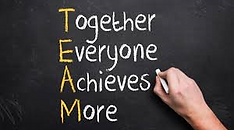
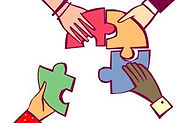
The Living Tree
ROOTS:the glasses symbolize my sister who has been one of the best and biggest caretaker in my life. In any situation I face, Diana is the first one that comes to mind. She is wise, knowledgeable and one of the best people to go to for any advice. She has definitely played a huge role in my personal and professional career. The engagement ring symbolizes my fiancée, who is another important caregiver in my life. Martin has motivated me and pushed me to never give up on my dreams and to continue to strive for success and greatness. The crowns symbolizes my parents, who are the most important people in my life. Without them, I wouldn’t be where I am today. My parents have shown me what it’s like to give and to love.
BRANCHES: the book/infinity sign symbolizes Sali, who has been my best friend for 8 years. She seems to always tell me to never stop trying. If I ever become discouraged, she is the one who picks me up to try again. The music sign symbolizes another one of my best friends, Aya, who reminds me what it is like to live and to be carefree. She has always been a person who can easily make me smile and remind me of how good life is.
FLOWERS: The happy face and heart symbolizes somethings that makes me feel good. The happy face represents of how I choose to live my life every day. The heart symbolizes my passion towards making people feel loved and to care for the people around me. I have always been passionate about caring for others and that makes me feel like a good person.
LEAVES: The first significant event is graduation which is in less than a month. I have been super excited to start my life and career but I know that I will miss those moments and assignments dearly. I have worked so hard all my life to be where I am and I am extremely proud of who I am as a person. The second event is my engagement which happened on April 17th, which was a complete shock to me. After 4 years, my best friend got down on one knee and asked me to be his wife and that was the perfect pre-graduation present. The last symbol is the money sign which is an event that represents job hunting and getting many interviews from multiple hotels and organizations. I have been blessed to interview at several places and preparing myself to find a job after graduation.
FRUIT: the pineapple, as we all know, represents the HTM program. My biggest achievement is entering this program and successfully finishing my courses in less than 3 weeks. The HTM program has made me so proud to be a fellow HTM Aztec!
SUMMING IT UP: at first, I thought this assignment was odd but I realized that it is the opposite of what I thought in the beginning. It made me think of what I have accomplished thus far in my time at SDSU as well as thinking of who has been a huge part of my successes. This assignment opened my eye to realize how truly blessed I am as a person

Signing Off, But Not Really...
This blog will be something I will cherish forever, it taught me things that I never knew and I learned about how true leaders become leaders. Before l knew what leadership really meant, I looked at it in a different way, more like a dictatorship. I was wrong in many ways, leadership is the opposite of dictatorship, it is about encompassing the ability to lead an individual or an organization and guide them towards the right direction. The theme in my blog consists of leadership that includes different images, articles, theories, qualities and many other things. This blog was truly one of the most amazing and fun things I have done throughout this semester!
